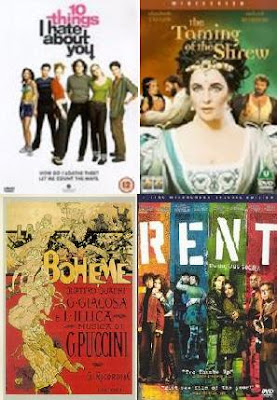 The other night, we went to a benefit concert for a local foundation that supports orphanages in foreign countries. They put on a Christmas concert of sorts, with many different genres of music: a classical violinist to a jazz band to a children’s choir. It was very well put together, and we had a great time.
The other night, we went to a benefit concert for a local foundation that supports orphanages in foreign countries. They put on a Christmas concert of sorts, with many different genres of music: a classical violinist to a jazz band to a children’s choir. It was very well put together, and we had a great time.One song that seemed to be out of place, however, was a montage from West Side Story that the violinist played. Because it wasn’t a Christmas song, as all the others were, it stood out to me and I started to think about it. I haven’t ever seen West Side Story, although I’ve always meant to, but I do know that the plot is loosely based on Shakespeare’s famous Romeo and Juliet.
I am reading a book right now called A Thousand Acres by Jane Smiley. The book is also based on a famous Shakespeare play, King Lear. I’ve enjoyed the book so far, as I am almost done, and it has been very interesting to see how the author placed the characters, events, and plot of the original neatly into a modern form—and it works.
As I sat there listening to the music, it got me thinking: Is everything we read, experience, hear, feel, something that has already been read, experienced, heard, and felt before? What is really “new”? Are all “new” things really old things just reworked?
I was listening to a morning show recently on my way to work, and the DJs were talking about an article in a magazine (Glamour or something) that talked about how all the movie stars who are popular now are really just revamped, stylized personalities of older movie stars who’ve come and gone—asserting that very little change actually takes place as “style” evolves. Interesting idea. Two examples I can remember were Audrey Hepburn, today as Natalie Portman, and Marilyn Monroe, today as Scarlett Johansson.
 There have been countless productions, books, etc. all based on works already in existence: La Boheme becomes Rent, Taming of the Shrew becomes 10 Things I Hate About You, The Odyssey becomes O Brother, Where Art Thou? In literature, King Lear becomes A Thousand Miles and Wuthering Heights becomes Here on Earth. As you are reading through this list, you’ve probably thought of a few yourself that you’ve come in contact with, rewrites of earlier works.
There have been countless productions, books, etc. all based on works already in existence: La Boheme becomes Rent, Taming of the Shrew becomes 10 Things I Hate About You, The Odyssey becomes O Brother, Where Art Thou? In literature, King Lear becomes A Thousand Miles and Wuthering Heights becomes Here on Earth. As you are reading through this list, you’ve probably thought of a few yourself that you’ve come in contact with, rewrites of earlier works.So, I ask you, what do you make of this “plagiaristic” technique? And truly, what isn’t plagiarized anymore? Everything we do is influenced by what we’ve seen, read, experienced. Are there any truly unique ideas left in the world? And if so, how would we recognize them?
I’ve been working on my wedding album lately, which still isn’t too close to being done two and half years after the fact.
I still can’t decide whether I think it good or bad, since society seems to frown on imitations. That negative, ugly word plagiarism makes my blood run cold with fear, being an editor. Should we be so afraid of copycats? I still don’t have an answer. But, whether it’s good or bad, one thing is clear: we are a breed of imitators. That must be why the saying was spawned, “Imitation is the sincerest form of flattery.”

2 comments:
"scraplifting"- how petty and protective can people be- that's outrageous.
I think we as human beings battle similar trials, and as such we experience similar feelings. But I think all experiences are unique in themselves, and how react and change from them are different. Ok, thats as deep as I go on vacation... :)
Post a Comment